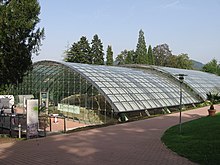Roman bath ruins in Badenweiler
The Römerbadruine Badenweiler is a ruin of a Roman thermal bath in Badenweiler in the district of Breisgau-Hochschwarzwald . It is one of the oldest buildings in Baden-Württemberg and is still one of the best preserved thermal baths north of the Alps.
history
Since 15 BC In several stages up to 150 AD, the Romans incorporated what is now south-west Germany into their world empire as part of the Germania Superior province . They also brought a well-developed bathing system with them, and thermal springs , which were already used in Celtic times, were used to create spa and medicinal baths . The source deities were supposed to guarantee the success of the cure; in the event of healing, sacrifices were made and some of them built their own altars. The Roman baths in Badenweiler was dedicated to the goddess of the Black Forest , Diana Abnoba , as the inscriptions found on site attest.
The thermal baths in Badenweiler were built in different phases, at least six can be proven. While a small building with two bathing pools was built in the first half of the 1st century AD, reception and changing rooms , sweating rooms with cold water pools and stone-enclosed terraces were added later.
After the Romans withdrew around AD 260, the ancient bathing culture ended in many places. Alemannic finds in Badenweiler, however, show that the facility was still used here for at least a while. While an older view suggests that the Germanic tribes eventually destroyed the bath, it is assumed that it could only have been decisively affected by the severe Basel earthquake of 1356 .
Research history
Only in the 18th century was there a renewed interest in the Roman bath. Margrave Karl Friedrich von Baden had the ruins uncovered again in 1784 and the finds protected by a series of measures. At the end of the 19th century, the ruins nearby received a new bath, the classical marble bath in the Pompeian style. In the following decades it was expanded several times. The thermal springs already used by the Romans, the warmest of which has a temperature of 26.4 ° C, established Badenweiler's reputation as a health resort.
Todays use
The Roman bath ruins were provided with a protective roof made of steel and glass in 2001, which has since protected the bath ruins from the weather. It is open for tours. A permanent exhibition offers a picture of Roman bathing culture. The Roman bath ruins are one of the state's own monuments and are looked after by the State Palaces and Gardens of Baden-Württemberg .
literature
- Meinrad N. Filgis: Discovered 225 years ago, presented under steel and glass. The Roman healing springs of Badenweiler. In: Preservation of Monuments in Baden-Württemberg , Volume 38, 2009, Issue 3, pp. 134–139 ( PDF )
- Werner Heinz: The Roman thermal bath ruins of Badenweiler and the problems of their conservation . In: Preservation of monuments in Baden-Württemberg , 8th year 1979, issue 4, pp. 165–169. ( PDF )
- Jürgen Köhler: Conservation, protection and presentation of the Roman thermal bath ruins in Badenweiler. In: Denkmalpflege in Baden-Württemberg , 25th year 1996, issue 1, pp. 98-102. ( PDF; 10.4 MB )
- Meinrad N. Filgis: Roman bath ruins Badenweiler. The historical roots of the health resort are presented anew. In: Monument Preservation in Baden-Württemberg , 30th year 2001, issue 4, pp. 166–175. ( PDF; 8.3 MB )
Web links
Individual evidence
- ^ Römerbadruine Badenweiler> Brief information. schloesser-magazin.de, archived from the original on October 14, 2007 ; accessed on November 13, 2016 .
- ↑ Sigrid Umiger: Before frescoes and in ruins . In: Badische Zeitung. June 20, 2011. Retrieved June 20, 2011.
Coordinates: 47 ° 48 ′ 10.2 " N , 7 ° 40 ′ 17.8" E



